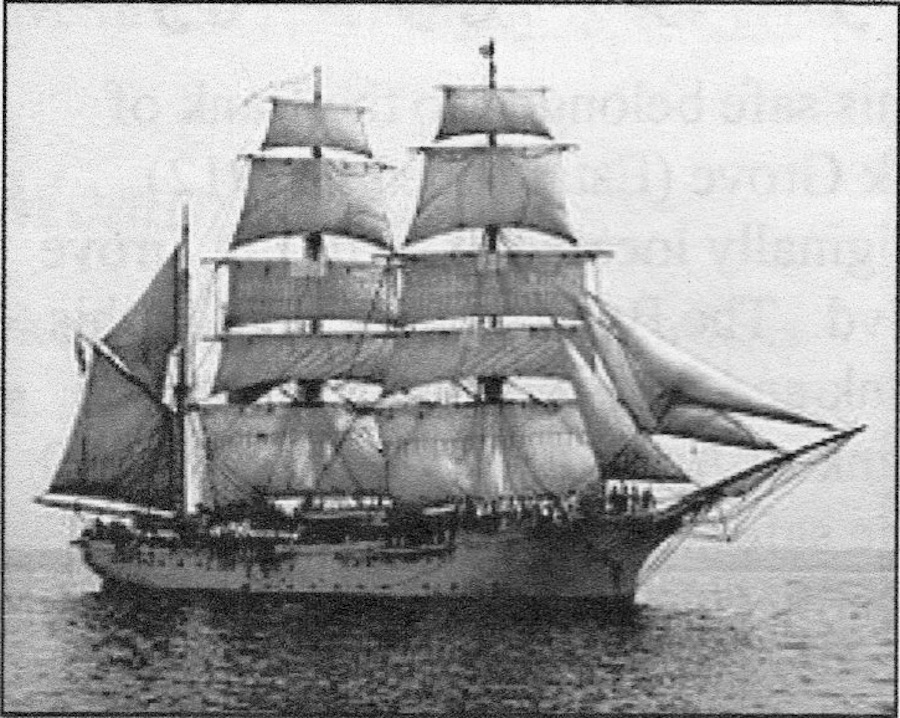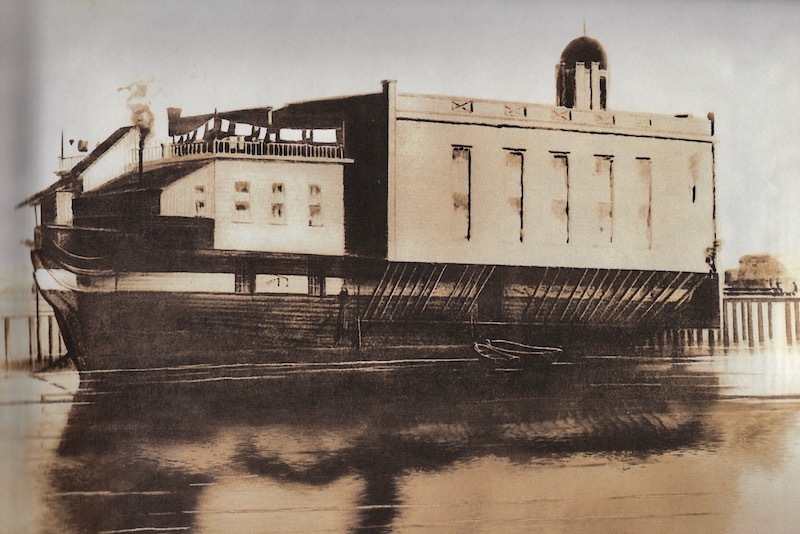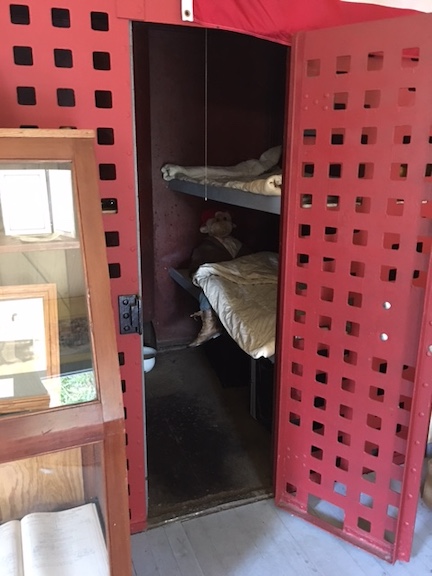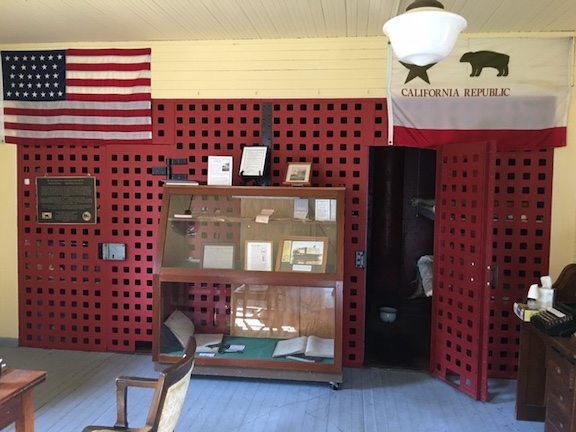The Cells of the Prison Ship LaGrange
The original jail for Sacramento county was a converted sailing bark (barque), the LaGrange bought from the men and women of the Salem & California Trading & Mining expedition. The LaGrange set sail out from Salem, Massachusetts on 19 March 1849 for the California gold fields with 63 men on board.
What is a Barque?
A barque is a vessel with at least three masts. The wooden three-masted barque was the most common type of deep water cargo-carrier in the middle of the 19th century. By the end of the eighteenth century, however, the term barque (sometimes, particularly in the USA, spelled bark) came to refer to any vessel with a particular type of sail-plan. This comprises three (or more) masts, fore-and-aft sails on the aftermost mast and square sails on all the other masts. Barque were the workhorse of the Golden Age of Sailing in the mid 19th century as they attained passages that nearly matched full rigged ships but could operate with smaller crews.

Around the Horn in 1949
Published in the Overland Monthly:
The writer trusts that “a plan, unvarnished tale” of his journey around the horn – jotted down at the time – may not be devoid of interest at the present day, when the pioneers to these shores are, one-by-one, life’s duties all performed with more or less faithfulness, leaving their earthly tenements of clay forever behind them, departing, let us hope, for the shores of a brighter world, to enter upon fields of more exalted usefulness.
The old adage of “a sailor’s lie is a dog’s life” found no support, I will venture to say, from the band of Argonauts, that, on the good LaGrange, made that pleasure trip of some 20,000 miles to the coast.
_______________________________________
Salem, Massachusetts, 1849 March 17th – Saturday 3:30 pm we cast off from the wharf, and in good barque “LaGrange,” Captain Joseph Dewing, made sail and started for San Francisco. Since noon, the crowd on the wharf had been continually increasing, until it numbered thousands, who had assembled to take leave of friends who were about to embark on a long and somewhat novel and perilous enterprise. Many now leave their homes for the first time, and none say it may not be the last.
“Cast off the bow fast; leave the ship, all who are not going to California,” sings out the pilot, and spreading the canvas to the northwestern breeze, her bow recedes from the wharf, the last grasp of the hand is given, friends hurry ashore, and excepting the pilot, none remain on board but those are to be intimate companionship for many long months
The roll having been called, and everyone – sixty-five in number, sixty-one in the company, two cooks and two passengers – having answered to his name, three hearty cheers were given by the company, and returned by those on the wharf.as they paused in their prolonged cheering, the four Baker brothers and Jesse Hutchinson were announced, and favored us with the following song, composed for the occasion by the latter:
“We’ve formed our band, and are all well manned,
To journey afar to the promised land,
Where the golden ore is rich in store,
On the banks of Sacramento’s shore”
Then heigh, boys, ho, to California go,
Where the mountains bold are covered with gold
On the banks for the Sacramento
Heigh ho, and away we go
Digging up gold in Sacramento.
Letter from Captain Joseph Dewing
Fanning’s Harbor, Falkland Islands, June 14, 1849
Please report by the first opportunity that may offer, at any port in the United States of America, that on the 9th of June 1849, the barque LaGrange of Salem, Massachusetts, U.S.A., Joseph Dewing Master, arrived here, having on board the Salem & California Mining and Trading Co., consisting of sixty-five persons, including two passengers, bound to San Francisco, Upper California, on a two years’ expedition, all well and enjoying the best of health, by the blessing of God. May his blessing and a long life attend you. By granting the above request you will confer a favor on.
Yours Respectfully, Joseph Dewing
The LaGrange sailed into San Francisco in September 1849 after a trip around the horn.
The ship arrived in Sacramento on October 3, 1849. As adequate jail space was not available, the “City” of Sacramento came up with a solution of creating a prison barge. The first of these barges was the barque Stafford which was rented by Sacramento County and served as a jail from March through May 1850. The second one, the Stirling, also rented by Sacramento County, floundered and sank. The LaGrange was the third and final jail and was purchased from the from the Salem & California Trading & Mining Company from $2,500 on June 14, 1850. The ship ordered to be moored at the mouth of the American River upstream from H Street to wait for its conversion to a prison ship.

With the LaGrange in place an additional $2,500 was authorized for repairs and alterations. In preparations for its new role, the ship was stripped of its masts and the hold was partitioned in cells and a superstructure added to the topside to properly fit the vessel as a jail. The forward cabin was built of oak and was used as a dungeon for the prisoners convicted of the worse crimes. Iron shafts embedded in oaken planks were added. In addition, a ball and chain was riveted to the leg of each prisoner to discourage escapes.
It served as the county jail from 1851 to November of 1859. Other ships were used as hotels and warehouses along the early waterfront before they too bowed to “time and the river.”
The “floating jail” era came to an end in November 1859 following heavy rains. The Sacramento Union reported on November 19, 1959 that:
About six o’clock yesterday morning the officers were aroused by cry of prisoners that the vessel was sinking, the water flowing freely, and partially flooding cells between decks.
The vessel sank sufficiently to admit water into the lumber hole forward, rendering it inadvisable to continue prisoners below, so they were admitted upon deck and closely watched till about a quarter to four p.m., when they were by concerted action of the sheriff, chief of police, and supervisors, transferred to the Station house, 33 prisoners in all, including three females…
As the barge was securely attached to its mooring at both bow and stern, it was prevented from rising with the rise of the water level. Soon only the peak of the superstructure and two small flag poles could be seen above the water. The water came in so fast that the prisoners that were housed there were barley saved. The LaGrange filled with water and sank to the bottom of the Sacramento River.
It sank in the heavy rain and floods that plagued early Sacramento. It was the third and last prison ship of the city and after that the jail remained on land. The ship was later salvaged, and the cells retrieved and used in the jail built on land. The metal tube in the center of cells was most likely the ventilation shaft from the cells to the topside of the old ship. If you look closely at the walls in the cells you will notice inscriptions and writings from prisoners once housed in these cells. Each cell could hold four prisoners. Notice the small opening at the bottom of each cell door. The opening would enable a jailor to pass food to the prisoners without opening the cells.


If you step into a cell and close your eyes you can almost imagine what it must have been like over 150 years ago for a prisoner in Sacramento.
Prisoner of the River
Nautical archeologists have explored three gold rush vessels and several later boats that are submerged in the Sacramento River.
In February 1986 archeologists located what is believed to be the wreckage of the LaGrange,“imprisoned” by riprap and mud just south of the I Street bridge. They found enough evidence – floor frames, hull planks, copper sheathing, curved timbers, and a keelson – to confirm that the vessel was an ocean-going sailing ship of LaGrange’s size and age.
There is a marker located in Old Sacramento State Historic Park, just west of the History Museum above the Sacramento River.
Newspaper Articles
Elk Grove Citizen, 26 June 1909: JAIL FOR ELK GROVE
Constable Hauskins who has had an application in some time for a jail here expects to have his hopes realized as soon as the old Sacramento city jail is torn down. Sherriff Reese says there 21 cells in the old jail, some of them being double and there will be enough to furnish different towns that need a jail, such as Elk Grove with two cells.
Elk Grove is in badly need of a jail, for the safe-keeping of criminals and drunks, who while they are in their intoxicated condition, are lower than the animals and should be placed where they will have no chance to offend the public and make a general nuisance of themselves.
At the present time Constable Hauskins’ only recourse when he arrests a drunk and wants to place him where he can be out of the way, is to use an S.P. box car for a jail. And if the prisoner is placed there for keeping overnight, some friend is sure to release him before morning.
Elk Grove Citizen, 23 September 1911: A CALABOOSE FOR ELK GROVE
The approach of winter and wet weather has made it necessary to provide comfortable quarters for our friends the hobos, who drift along this way like birds of passage, so on Wednesday, men and teams in the charge of Deputy Constable “Pinkey” Benton, went to Sacramento to bring out two of the steel cells that formerly were in the old county jail, and these are to be made into a calaboose on the county’s lot back of the Odd Fellows building. The town has known the need of a jail, or lockup of some kind for a long time, not for its citizens, but for the chaps who drift along here without visible means of support. Hereafter, “Jack” and “Bo” will have to be able give a good account of themselves when they stop in Elk Grove, or it will be the calaboose for them.
Elk Grove Citizen, 30 September 1911: JAIL
It appears to be hard to determine whether our new jail building shall be Old Mission Bungalow style or Early Italian renaissance. The tastes of the perspective tenants are likely to be various.
Elk Grove Citizen, 3 February 1912: CITY BASTIILE
Elk Grove is to have a place to confine lawbreakers. Workmen in the employ of J.M. Derr are erecting an 18 x 24 foot building on a concrete base over the steel cells recently donated by the county. The jail is being erected on the lot just north of Jones & Colton’s store (Odd Fellows building). Tourists on foot are warned to keep on the move.
Elk Grove Citizen, 1911 October 28:
Le Hotel de l’Citie de Elk Grove has formally dedicated to its sovereign God Bo, guardian and ruler of all tramps and itinerant indigents.
Then above is not really the name of the place; those words are, we fondly hope, French for the town calaboose. They may mean something entirely different, too, for it is a singular fact that we never yet met a Frenchman who could, nor would speak French the way we speak it. Isn’t it annoying to try to converse with a foreigner in his native tongue only to find that he is so stupid that he can’t understand a word you are saying? Sh’d sayso.
However, this has nothing to do with what we started to talk about. That is characteristic of writing; we so frequently say things that have no relevance to anything that we ever have said before or may say afterwards. Although the present is an ideal time to subscribe.
The man’s name was, and to the best of our knowledge and belief still is, Ad Peterson. He had been bean glommer somewhere in the vicinity of Elk Grove, but he had a serious eye trouble that interfered with his work; everything he saw made him think of a glass of beer and if he saw it twice he thought of a brewery, so what skol poor Svedish fallar bane gon do? He yumped his job and came to the Grove to get two or three drinks, after which he has seventy-five or thirty more and some ore. They found him sleeping in the Sunrise Suite of the Bastille next morning. He said, “By yimminy! Das bane one dam col’ badroom for a svedish fallar!
And thus the town jail has been dedicated to the great God Bo.
TIMELINE: Ship, Cells, & Jail
1849 – Gold Rush in California begins
1849 March 17 – Barque LaGrange, Joseph Dewing Master, departs Salem, Massachusetts bound for San Francisco, California. Expedition of the Salem & California Mining & Trading Company
1849 June 14 – Captain Joseph Dewing writes a letter from Fanning’s Harbor, Falkland Islands
1849 September – Barque LaGrange arrived in San Francisco
1849 October 3 – The LaGrange arrives in Sacramento
1850 June 20 – Sacramento Purchased the Barque LaGrange for $2,500
1851 – Barque LaGrange turned into a prison ship in Sacramento
1859 November 18 – Prison ship LaGrange sank during a weeklong storm
1863 – Prison cells salvaged from the LaGrange
1911 September 21 – Elk Grove gets two cells from the LaGrange prison ship and builds a jail with the help from J.M. Derr
1912 – The San Joaquin Township Justice Court & Jail Opens for business.
1941 – The San Joaquin Township Courthouse & Jail is used as a temporary observation post during Worl War II
1983 – The San Joaquin Township Courthouse & Jail is moved to Heritage Park to be renovated by the Elk Grove Historical Society
1986 – Archeologists locate what is believed to be the wreckage of the Barque LaGrange prison ship near the I Street bridge
1999 – Aaron Larson from the Boy Scout Troop #394 took on the Courthouse & Jail restoration as his Eagle Scout project.
2000 March 14 – Renovation of the San Joaquin Township Courthouse & Jail is completed
2000 July 1 – Elk Grove is incorporated as a city
2003 – The Elk Grove Hotel & Stage Stop and the San Joaquin Township Courthouse & Jail opened to the public by the Elk Grove Historical Society
2012 June 12 – The Elk Grove Historical Society celebrates the 100th Anniversary of the San Joaquin Township Courthouse & Jail
All the information obtained for this article was from the research of and articles written by Anita Peters (2008) and Barbara Claire (2012).